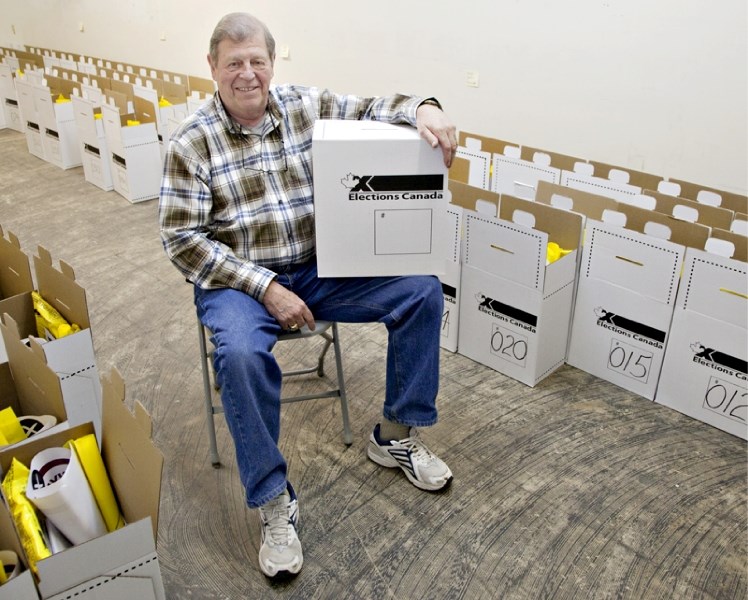Voters have it easy on election day compared to Bill Wright. As a returning officer, he and his team will have to count about 94,000 ballots from 235 locations in the space of a few hours.
And he'll probably love every minute. "I love the stress," says Wright. "I really do. I thrive on that."
Wright, 68, has been the Elections Canada returning officer for Edmonton-St. Albert since 2000. This is his fifth federal election.
You get all sorts of surprises at the polls, he says: wrong IDs, no IDs, chewed up ballots and even marital disputes.
"You have to make a decision based on the Canada Elections Act and common sense," he says, and fast — people don't like to wait for their vote.
Ballot stations, people!
Wright and his team at Grandin mall have spent the last month training hundreds of people to manage this region's 235-some polls. Each gets a ballot box, some forms and a stack of ballots, as well as official Elections Canada rulers and other paraphernalia.
The team has also had to update the 94,000-some names on the voters list.
"We've had about 2,000 changes since we opened two weeks ago," he says, and they're expecting more come election day. Elections Canada has a long list of documents you can use to register at the polls, he notes. "Your current driver's licence with your current address is the best."
And they've already taken ballots from some 6,952 people at last week's advance poll — a turnout 43 per cent larger than the advance poll in 2008.
"There were people lined up out the door," Wright says. The long weekend plus the lack of a poll at Muriel Martin may have contributed to the high turnout, he says. "It was certainly the biggest Friday we've had."
Once the polls open at 7:30 a.m., poll workers will have to confirm the name and address of each voter before handing over a ballot.
This can lead to some strange situations. Wright recalls one man two or three elections ago that was just about to vote when a woman behind him said, "I challenge that because he does not live at that address." Turns out she was his wife, and she'd thrown him out of the house.
"This guy was a taxpaying citizen and had the right to vote," Wright says. Since the man was living in a car parked in front of a friend's house, they re-registered him at that address and gave him a ballot.
Watching all these activities are the scrutineers. These candidate representatives track voters as they come in to ensure their supporters get to the polls.
It can get pretty boring, says Richard Plain, past scrutineer and current campaign manager for Brent Rathgeber, but it gets pretty hectic around 5 p.m. during the post-work rush.
"Most scrutineers would hope it would be boring," he notes, as that means a smooth vote.
The ballots themselves have stayed pretty much the same since the 1960s, Wright says: a piece of paper where you mark an X in a circle. "It works," he says, and it avoids the infamous "hanging chad" problems of other ballots. Each comes with a removable numbered tag for accounting purposes.
"We want you to mark with an X," Wright emphasizes. If you colour in the circle or make a vague mark, your ballot may be rejected (did the voter mean "this candidate" or "everyone but this candidate"?).
Finished ballots go in the ballot box, he says — usually. Some get eaten, torn up, or taken home. "We've had people who put a great big X across the whole ballot and throw it at the returning officer."
The count, and what's next
Returning officers crack open the boxes at 7:30 p.m. and start counting, Wright says, using the numbered tags to spot any fake or missing ballots. Each officer reads the candidate listed on the ballot aloud and puts it in the appropriate pile.
Scrutineers can watch, but cannot interfere. Once the count is finished, the ballots are returned to the boxes and sealed in heavy plastic — never to be reopened without a judge's order.
Media outlets will report unofficial results Monday night, but Wright's crew won't enter the official numbers until 11:30 a.m. Tuesday. They'll have the final results sent to Ottawa by 2:30 p.m., after which Elections Canada will have two weeks during which to declare a winner.
After that, Wright's crew packs up the office, purges the computers and archives the ballot boxes. "We end up with an empty room just as we found it six weeks prior." Wright himself stays on the job for months afterwards to vet campaign expenses and prepare for the next election.
Despite the 80-hour workweek, Wright says he doesn't plan to get out of the elections business anytime soon. To him, it's about serving democracy. "We fought for this, and it's dear to my heart."
Call 1-866-432-1039 for any election questions.
What do I need to vote?
Elections Canada gives voters three ways to register to vote at the polls.
o Present an original piece of government-issued ID with your name, address and photo (e.g. driver's licence)
o Show two pieces of ID, both with your name, one with your address, that are on Elections Canada's approved list (e.g. Canadian passport and credit card statement, government cheque and library card)
o Take an oath and get someone who knows you and is registered to vote in your district to vouch for you
Your voter identification card is not a valid form of ID, but will help pollsters get you to the right poll.
A full list of valid IDs is available at www.elections.ca.




